| Prev | ICM User's Guide 4.4 Labeling and Annotation | Next |
[ Labeling | Atoms | Residues | Move | Variables | Sites | Annotation | Label Color | Custom Labels | Undisplay Label | Displaying Distances | Origin | Tethers | Dist/Restraints | Display Clash | Rainbow, Box and Ruler | Display Gradient ]
To add labels or display or undisplay pre-defined annotation:
- Select the atoms, residues, molecules, or objects you wish to label in the graphical display or in the ICM Workspace.
- Then use the label options in the Display Tab.
To add new user-defined annotation:
- Select the atoms, residues, molecules, or objects you wish to label in the graphical display or in the ICM Workspace.
- Right click on the selection and choose "Annotate Selection".
4.4.1 Labeling |
Labeling options are contained within the Labels or Display Tab. In many cases clicking and holding a label button will allow you to view more options.
4.4.2 Labeling Atoms |
Select the atoms you wish to label (see display structure or selection toolbar).
- Select the display tab.
- Click the label ATOM button.
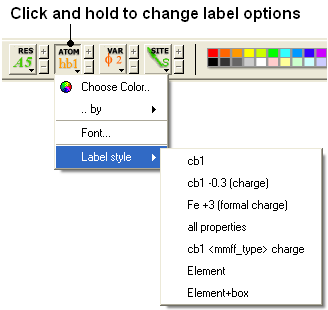
To change the level of label detail:
- Click and hold the label ATOM button and select the desired level of label detail, color or style.
4.4.3 Labeling Residues |
To label residues:
- Select the display tab.
- Select the residues you wish to label (see display structure or selection toolbar).
- Click the label RES button.
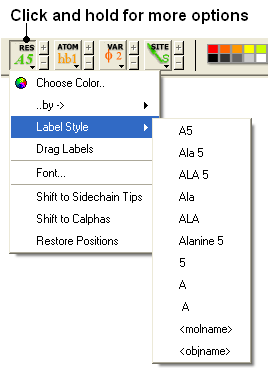
To change the level of label detail:
- Click and hold the label RES button and select the desired level of label detail or style.
4.4.4 Move Residue Label |
To change the location of your residue label:
- Select View/Drag res labels.
- If your mouse has a middle mouse button, then click on handle (as shown) of the label you wish to move, and drag it to your desired area.

- If your mouse has no middle mouse button, then click on the Translation icon on the toolbar, and click on the handle (as shown) of the label you wish to move, and drag it to your desired area.
The +/- buttons on the side of the Residue and Atom buttons will shift the label. There are also other residue label move options available when you click and hold the residue label button. These options include Shift to Sidechain Tips, Shift to Calphas, and Restore Positions
4.4.5 Label Variables |
To label variable angles (dihedral-torsion, planar and phase angle) the molecule needs to be converted into an ICM object.
- Convert the molecle to an ICM object.
- Select the atoms for which you would like to display the variables (see display structure or selection toolbar).
- Click on the toggle variable label button shown above located in the display tab.
- Change the font size by using the +/- buttons.
- Change the font and color by clicking and holding on the variable atom label button.
To change the variable label style click and hold the variable atom label button as shown below.
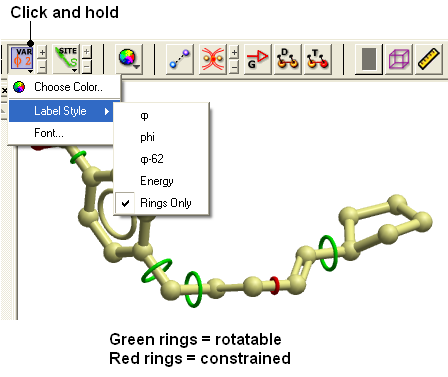
Rings of varying diameter and color are superimiposed on rotatable bonds. Green rings with large diameter are considered less constrained than rings with small green rings. Red rings are highly constrained and non-rotatable. When the Label Style/Energy option is selected the first number displayed represents the bond angle, the second the energy and the third the worst energy that could be achieved by rotating the bond.
4.4.6 Labeling Sites |
To display and undisplay sites use the Toggle Site Label button shown below
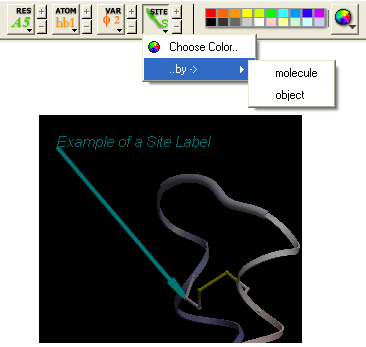
- Click the label SITE button.
To change the level of label detail:
- Click and hold the label SITE button and select the desired level of label detail or style.
| NOTE: To create your own site labels see the Label Annotation section. |
4.4.7 Annotation |
To annotate a protein structure. Select the region you wish to annotate (see Selection Toolbar).

- Right click on the selection.
- Select the option Annotate Selection.
- Enter the annotation into the text box and select ok
To change the detail (such as residue number) contained within the annotation.
- Click in the bottom left hand corner of your annotation.
To undisplay an annotation click on the site button in the Display tab.
To permanently delete an annotation.
- Right click on the Sites box in the ICM Workspace and select delete (see below).
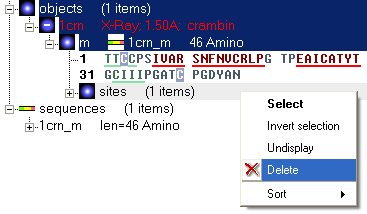
To change the direction the arrow is pointing or move the arrow.
- Click on the translation button (or use the middle mouse button).
- Click on the end of the arrow and drag to the desired position.
4.4.8 Changing Label Colors |
To change the color of any label:
- Click and hold down the required label button and a menu as shown below will be displayed.

- Select color.
4.4.9 Customized Label 2D or 3D |
To generate a customized a label:
- Select the labels tab.
- Select either 2D or 3D button.
- Enter your label and select the desired color, font and size.
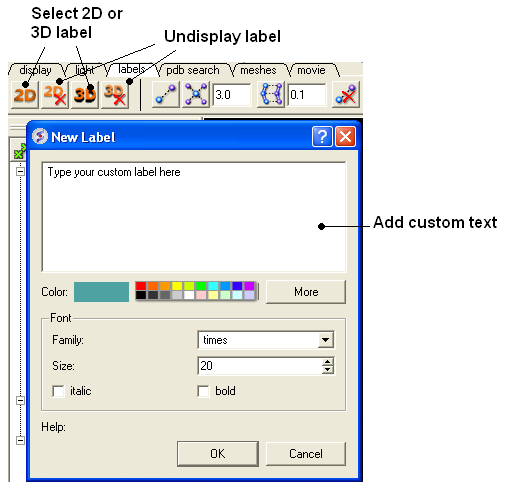
To edit or delete a label - right click on the label in the graphical display as shown below.
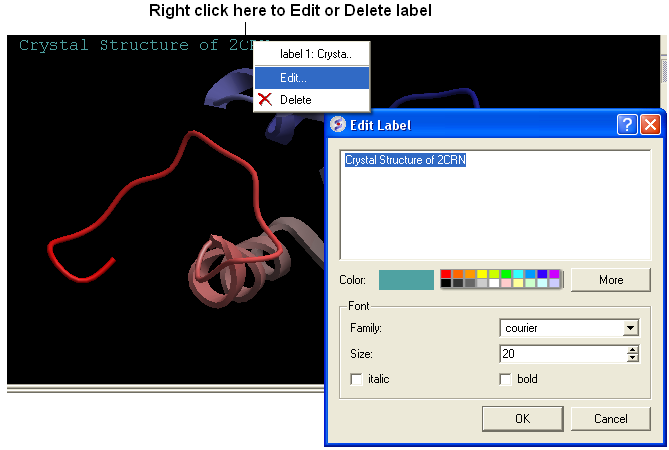
4.4.10 Undisplay Customized Label |
Undisplay Residue, Atom, and Variable Label Any label that is displayed can be undisplayed by selecting the region of the molecule related to the label and clicking on the corresponding label button in the labels tab. For example if you wish to undisplay an atom label - click the atom label button. If a label is displayed the coresponding button in the display tab will be shaded blue. When you delete the button will return to grey. 2D and 3D labels have an undisplay button (red cross on the button see customized label section).
Undisplay 2D or 3D label Click onthe undisplay label button in labels tab.
| NOTE: A label can also be deleted by right clicking on the label in the graphical display and selecting delete. |
4.4.11 Labeling Distances |
Within the labels tab there are tools for calculating and displaying distances. These tools can also be found in the Tools/Analysis menu.

To display distance between two atoms:
- Click on the labels tab (previously called advanced tab).
- Select the atoms between which you would like to find the distance. (See selection toolbar)
- Click on the 'Show Distances Between Two Atoms' Button
- The distance will be displayed in angstroms, in green.

To find the distance from one atom to many:
- Click on the labels tab (previously called advanced tab).
- Select the atom from which you wish to measure the distance from (See selection toolbar)
- Click on the 'Show Distances From One Atom To Many' button.
- The distances will be displayed in green.
The maximal and minimal distances can be selected by entering values in the boxes shown here (below) in the labels tab (previously called Advanced tab).
![]()
| NOTE: Distances can be displayed and undisplayed in the 3D labels section of the ICM Workspace. See image below. |
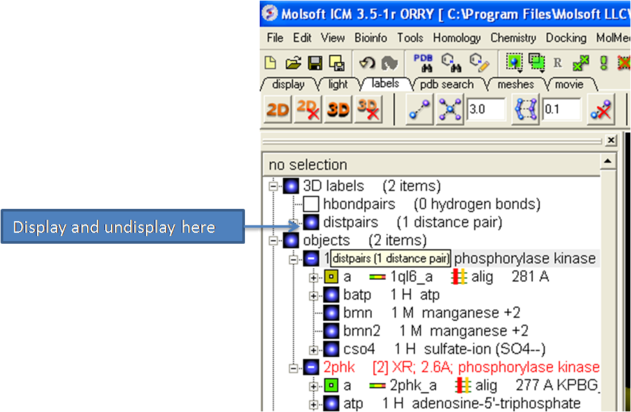
To change the color of the distance label
- Right click on the distpairs under the 3D labels section of the ICM workspace and select Change Color.
4.4.12 (Un)display Origin |
To display and undisplay the axis of the coordinate frame (origin):
- Select the labels tab and select the toggle origin button.

4.4.13 Displaying Tethers |
Theory
A tether is a harmonic restraint pulling an atom in the current object to a static point in space. This point is represented by an atom in another object. Typically, it is used to relate the geometry of an ICM molecular object with that of, say, an X-ray structure whose geometry is considered as a target. Tethers can be imposed between atoms of an ICM-object and atoms belonging to another object, which is static and may be a non-ICM-object. You cannot create tethers in ICM-Browser, however, if the project that you have loaded contains tethers between two objects, then they can be displayed:
- Click on the display tab (previously called advanced tab).
- Click on the 'Toggle Tethers' button.
4.4.14 Displaying Distance Restraints |
Theory
A distance restraint imposes a penalty function on the distance between two atoms in the same object. You cannot create distance restraints in ICM-Browser, however, if the project that you have loaded contains distance restraints, then they can be displayed:
- Click on the display tab (previously called advanced tab).
- Click on the 'Toggle distance restraints' button.
4.4.15 Display Clash |
To display a clash the file needs to be an ICM Object.
- Select the region around which you would like to identify clashes.
- Select the display tabs and the "toggle clashes" button shown below.
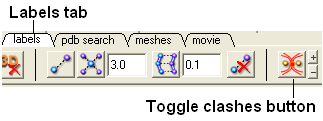
4.4.16 Display Rainbow, Box, Ruler |
To (un)display a rainbow key, box or ruler use the buttons shown below located i n the display tab.

4.4.17 Display Gradient |
This button is located in the display tab.

This option is described in detail in the language manual http://www.molsoft.com/man/icm-commands.html#display-gradient
| Prev Lighting | Home Up | Next Distances and Angles |